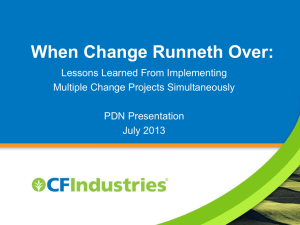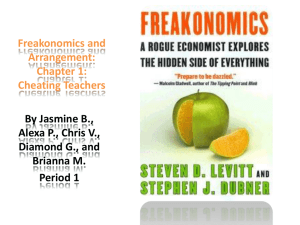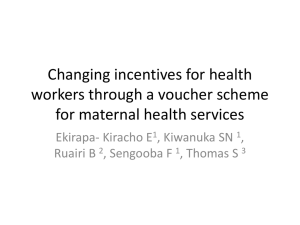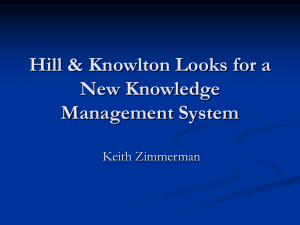third paper calls for more work to be done on generating market
advertisement
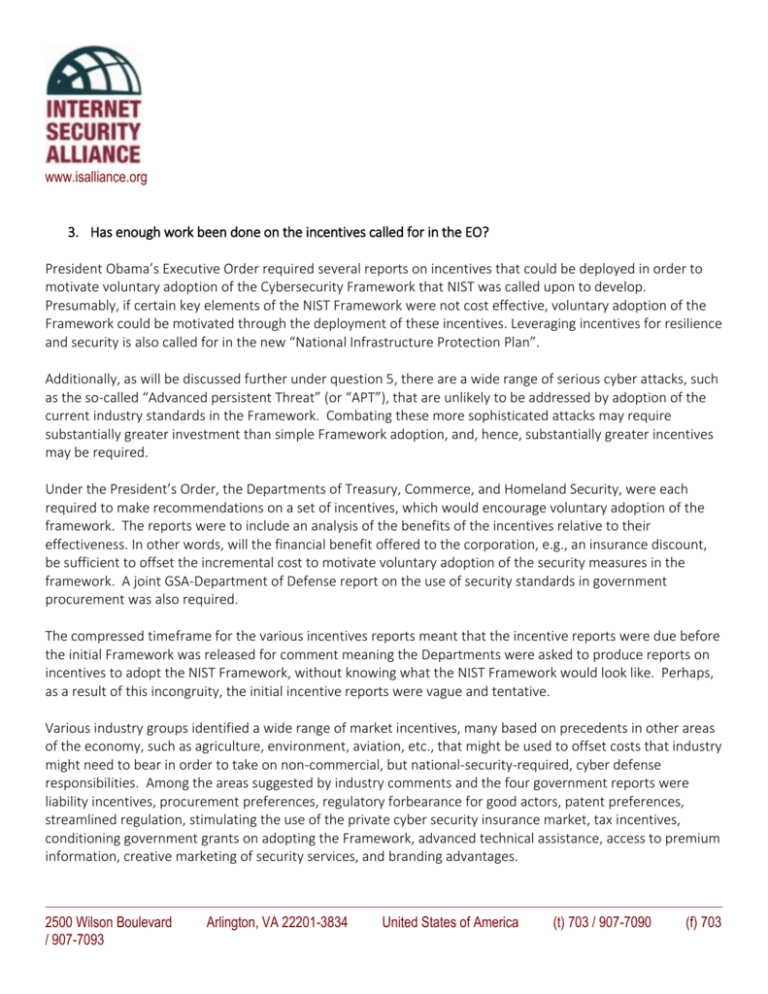
www.isalliance.org 3. Has enough work been done on the incentives called for in the EO? President Obama’s Executive Order required several reports on incentives that could be deployed in order to motivate voluntary adoption of the Cybersecurity Framework that NIST was called upon to develop. Presumably, if certain key elements of the NIST Framework were not cost effective, voluntary adoption of the Framework could be motivated through the deployment of these incentives. Leveraging incentives for resilience and security is also called for in the new “National Infrastructure Protection Plan”. Additionally, as will be discussed further under question 5, there are a wide range of serious cyber attacks, such as the so-called “Advanced persistent Threat” (or “APT”), that are unlikely to be addressed by adoption of the current industry standards in the Framework. Combating these more sophisticated attacks may require substantially greater investment than simple Framework adoption, and, hence, substantially greater incentives may be required. Under the President’s Order, the Departments of Treasury, Commerce, and Homeland Security, were each required to make recommendations on a set of incentives, which would encourage voluntary adoption of the framework. The reports were to include an analysis of the benefits of the incentives relative to their effectiveness. In other words, will the financial benefit offered to the corporation, e.g., an insurance discount, be sufficient to offset the incremental cost to motivate voluntary adoption of the security measures in the framework. A joint GSA-Department of Defense report on the use of security standards in government procurement was also required. The compressed timeframe for the various incentives reports meant that the incentive reports were due before the initial Framework was released for comment meaning the Departments were asked to produce reports on incentives to adopt the NIST Framework, without knowing what the NIST Framework would look like. Perhaps, as a result of this incongruity, the initial incentive reports were vague and tentative. Various industry groups identified a wide range of market incentives, many based on precedents in other areas of the economy, such as agriculture, environment, aviation, etc., that might be used to offset costs that industry might need to bear in order to take on non-commercial, but national-security-required, cyber defense responsibilities. Among the areas suggested by industry comments and the four government reports were liability incentives, procurement preferences, regulatory forbearance for good actors, patent preferences, streamlined regulation, stimulating the use of the private cyber security insurance market, tax incentives, conditioning government grants on adopting the Framework, advanced technical assistance, access to premium information, creative marketing of security services, and branding advantages. 2500 Wilson Boulevard / 907-7093 Arlington, VA 22201-3834 United States of America (t) 703 / 907-7090 (f) 703 Many of the incentive ideas had multiple levels of operational adaptability. For example, procurement, liability and insurance incentives could be used to motivate many different types of pro-security behavior. Following the submission of the various government reports in early spring of 2013, White House National Cybersecurity Coordinator Michael Daniel posted a blog entry enumerating many of the incentive options that the White House planned to consider further. Unfortunately, the incentive development process seems not to have progressed much beyond Mr. Daniel’s blog. Indeed, there have been no follow up reports from the White House, or from any other federal entity since Mr. Daniel’s August blog entry. The President’s Order also calls for regulatory agencies to review their current authority to encourage adoption of the Framework within 90 days its February 2014 publication. However, the Order specifies that this review must also be guided by previous Executive Order Executive Order 12866, Section 1(b) that states that: “(3) Each agency shall identify and assess available alternatives to direct regulation, including providing economic incentives to encourage the desired behavior, such as user fees or marketable permits, or providing information upon which choices can be made by the public…. (and) “(5) When an agency determines that a regulation is the best available method of achieving the regulatory objective, it shall design its regulations in the most cost-effective manner to achieve the regulatory objective. In doing so, each agency shall consider incentives for innovation, consistency, and predictability, the costs of enforcement and compliance (to the government, regulated entities, and the public), flexibility, distributive impacts, and equity.” To ISA’s knowledge, there have been no meetings with industry to substantively explore the cost of implementing the framework. No timetable exists for considering, let alone deploying, the incentives that might have substantive economic impact on adopting the Framework. Although Administration officials often cite the need for Congress to enact some of the incentives, they have also said they have no plans to suggest a package to the Congress. Although NIST was funded to hold 5 nationwide workshops to develop a Framework of aggregated standards and practices, there was no similar effort to understand the cost to industry such that incentives could be developed to motivate critical infrastructure to voluntarily adopt the Framework. Especially given the fact that the Framework development process itself failed to address the required cost effectiveness issue, the lack of progress in developing the incentive proposals industry has made has resulted in a Framework of indeterminate cost and benefit with no added motivation for its voluntary adoption. Thus it is questionable as to if the framework effort will result in any significant security beyond what already exists. 2500 Wilson Boulevard / 907-7093 Arlington, VA 22201-3834 United States of America (t) 703 / 907-7090 (f) 703


